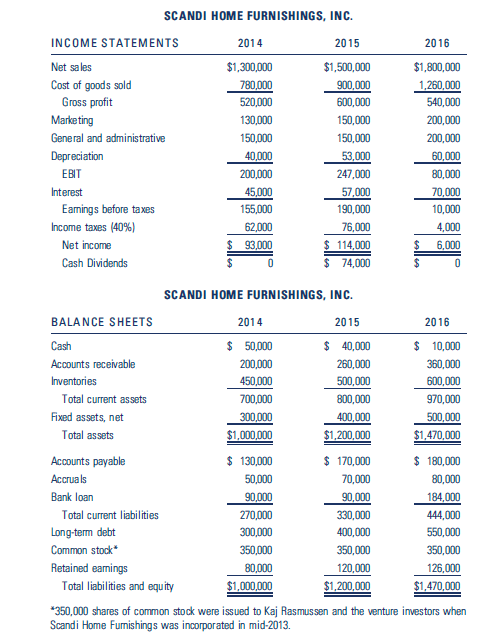Question:
Kaj Rasmussen founded Scandi Home Furnishings as a
corporation during mid-2013. Sales during the first full year (2014) of operation reached $1.3 million. Sales increased by 15 percent in 2015 and another 20 percent in 2016. However, after increasing in 2015 over 2014, profits fell sharply in 2016, ausing Kaj to wonder what was happening to his €œpride-andjoy€ business venture. After all, Kaj worked as closely as possible to a 24/7 pace, beginning with the startup of Scandi and continuing through the first three full years of operation. Scandi Home Furnishings, located in eastern North Carolina, esigns, manufactures, and sells Scandinavian-designed furniture and accessories to home furnishings retailers. The modern Scandinavian design has a streamlined and uncluttered look. While this furniture style is primarily associated with Denmark, both Norwegian and Swedish designers have contributed to the allure of Scandinavian home furnishings. Some say that the inspiration for the Scandinavian design can be traced to the elegant curves of art nouveau from which designers were able to produce aesthetically pleasing, structurally strong modern furniture. Danish furnishings and the home urnishings produced by other Scandinavian countries€”Sweden, Norway, and Finland€”are made using wood (primarily oak, maple, and ash), aluminum, steel, and high-grade plastics. Kaj grew up in Copenhagen, Denmark, and received an undergraduate degree from a technical university in Sweden. As is typical in Europe, Kaj began his business career as an apprentice at a major home furnishings manufacturer in Copenhagen. After learning the trade, he quickly moved into a management position in the firm. However, after a few years, Kaj realized that what he really wanted to do was to start and operate his own Scandinavian home furnishings business. At the same time, after travelling throughout the world, he was sure that he wanted to be an entrepreneur in the United States. Kaj moved to the United States in early 2013. With $140,000 of his personal assets and $210,000 from venture investors, he began operations in mid-2013. Kaj, with a 40 percent ownership interest and industry-related management expertise, was allowed to operate the venture in a way that he thought was best for Scandi. Four years later, Kaj is sure he did the right thing. Following are the three years of income statements and balance sheets for Scandi Home Furnishings. Kaj felt that that he would need to continue to expand sales to maintain a competitive dvantage. After first concentrating on selling Scandinavian home furnishings in the Northeast in 2014 and 2015, he decided to enter the West Coast market. An increase in expenses occurred associated with identifying, contacting, and selling to home furnishings retailers in California, Oregon, and Washington. Kaj Rasmussen hopes that you can help him better understand what has been happening to Scandi Home Furnishings from both operating and financial standpoints.

A. An analysis of the cash conversion cycle should also help Kaj understand what has been happening to the operations of Scandi. Prepare an analysis of the average conversion periods for the three components of the cash conversion cycle for 2014€“2015 and 2015€“2016. xplain what has happened in terms of each component of the cycle.
B. Kaj has been able to obtain some industry ratio data from the home furnishings industry trade association to which he belongs. The industry association collects proprietary financial information from members of the association, compiles averages to protect the proprietary nature of the information, and provides averages for use by individual trade association members. Over the 2014€“2015 and 2015€“2016 periods, the inventory-to-sale conversion period has averaged 200 days, while the sale-to-cash conversion period (days of sales outstanding) for the industry has averaged 60 days. How did Scandi€™s operations compare with these industry averages in terms of these two components of the cash conversion cycle?
Cash Conversion Cycle
Cash conversion cycle measures the total time a business takes to convert its cash on hand to produce, pay its suppliers, sell to its customers and collect cash from its customers. The process starts with purchasing of raw materials from suppliers,...
Corporation
A Corporation is a legal form of business that is separate from its owner. In other words, a corporation is a business or organization formed by a group of people, and its right and liabilities separate from those of the individuals involved. It may...
Transcribed Image Text:
SCANDI HOME FURNISHINGS, INC. INCOME STATEMENTS 2016 2014 2015 Net sa les $1,300,000 $1,500,000 $1,800,000 Cost of goods sold Gross profit 780,000 900,000 1,260,000 540,000 520,000 600,000 Marketing 130,000 150,000 200,000 General and administrative 150,000 150,000 200,000 Depreciation 40,000 60,000 53,000 EBIT 200,000 247,000 80,000 Interest 45,000 57,000 70,000 Eamings before taxes Income taxes (40%) 155,000 190,000 10,000 62,000 4,000 76,000 $ 114,000 $ 93,000 Net income %24 6,000 $ 74,000 Cash Dividends 24 %24 SCANDI HOME FURNISHINGS, INC. BALANCE SHEETS 2015 2014 2016 $ 50,000 $ 40,000 $ 10,000 Cash 360,000 600,000 Accounts receivable 260,000 200,000 Inventories 450,000 500,000 Total current assets 700,000 800,000 970,000 Fixed assets, net 300,000 500,000 400,000 Total assets $1,000,000 $1,200,000 $1,470,000 $ 170,000 $ 130,000 $ 180,000 Accounts payable Accruals 50,000 70,000 80,000 Bank loan 90,000 90,000 184,000 Total current liabilities 270,000 330,000 444,000 Long-term debt 300,000 550,000 400,000 Common stock" 350,000 350,000 350,000 120,000 $1,200,000 Retained eamings Total liabilities and equ ity 80,000 126,000 $1,000,000 $1,470,000 *350,000 shares of common stock were issued to Kaj Rasmussen and the venture investors when Scandi Home Fumishings was incorporated in mid-2013.







